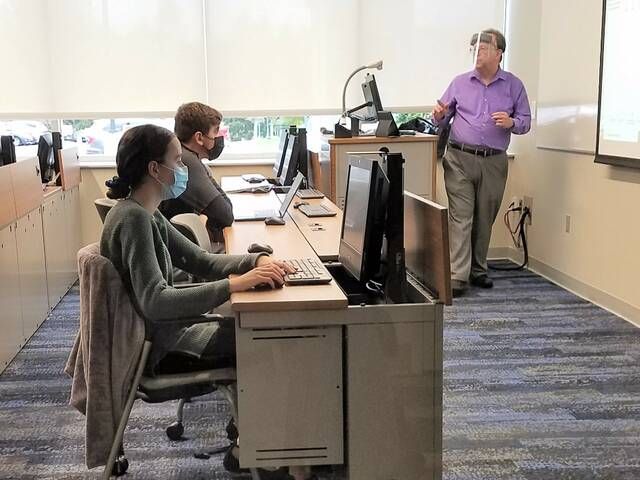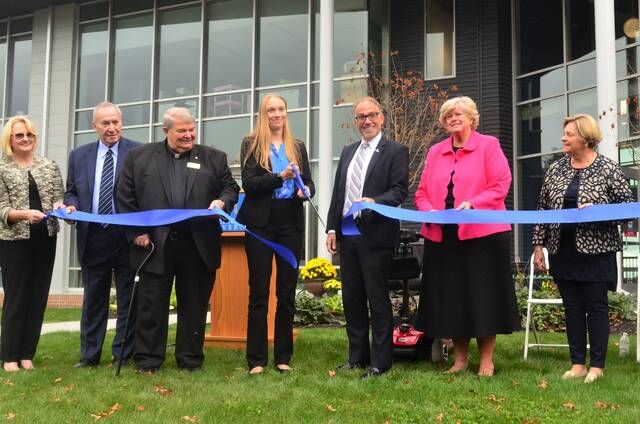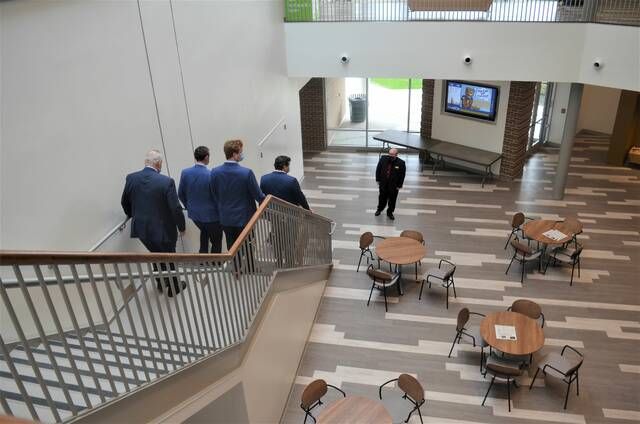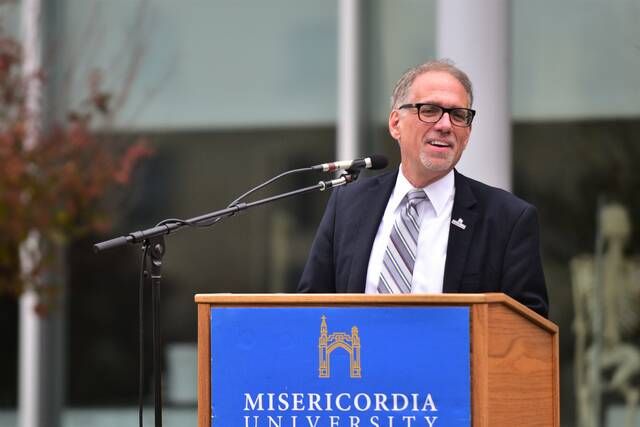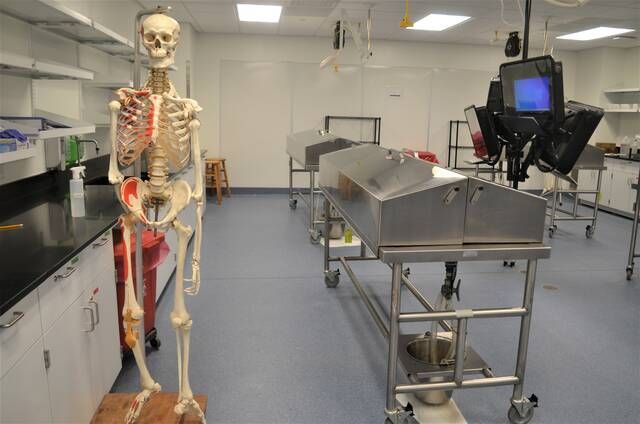
A model of a human skeleton aptly stands watch over the gross anatomy cadaver room in Misericordia University’s expanded and updated Frank M. and Dorothea Henry Science Center, officially dedicated Friday morning.
Mark Guydish | Times Leader
Click here to subscribe today or Login.
DALLAS TWP. — The jokes started before the door opened.
“This is the gross anatomy lab, but you won’t see anything gross,” Misericordia University Biology Professor Anthony Serino said on a tour of the school’s science center Friday. While the lab does have real cadavers for student work, “everything’s put away, you won’t see anything.”
“Can we see them?” One of the people in the group said with a chuckle.
Inside the room, with the metal covers of the cadaver tables glistening and state-of-the art equipment bristling, Serino said in a more serious tone “When students come in here the first time they’re so stunned, they’re silent.”
“Dead silent,” another in the group offered, no rim shot included.
Serino and others gave small group tours before the official ribbon cutting and dedication of the radically updated and expanded Henry and Dorothea Science Center, with the old section completely revamped and the new section increasing the available square footage to an impressive 77,000 square feet. (Serino conceded the university boasts it’s more than 85,000 square feet, but said that’s measuring around the outside walls)
The gross anatomy lab sports movable lights and coiled electric outlet cords above each table to give both clear views and clear access for plugging in any power equipment needed to fully examine the cadavers, which come through a national registry from people who agree to donate their bodies for such teaching settings.
But the eight cadavers currently available — preserved to last for months of lessons — aren’t the only way to learn. The new center also has a sophisticated 3-D virtual cadaver lab.
The center is so high-tech the new greenhouse — initially not in the budget but added on to one outside wall thanks to a generous donation — has Mylar sheets on the clear roof that can be adjusted to control the amount of sun coming in. Some rooms have computers that rise up from inside the desk if students need it, or stay hidden if they want the desk space.
There’s an aquarium room and an animal vivarium suite where small animals can be raised and housed. The Chemistry lab hooded stations, designed to allow work on something while fumes are vacuumed away — are automatically controlled so the air being drawn out increases as the hoods are raised higher.
Serino commented repeatedly on how much more space there is, finally giving each lab type its own rooms. “In the old buildings labs had to be shared,” he said.
“It was like closet space,” one person familiar with the old building said.
“No, we called those offices,” Serino said, not missing a beat.
One lab is equipped with walk-in cold storage to do work previously handled by a refrigerator. An available room was converted to a DNA sequencing and analysis lab for a student’s work. “We never had the space to offer something like that before.”
There’s an atomic force microscope that uses lasers to measure in resolutions of nanometers. There’s a hallway showcase with fossils, real and cast, from a range of animals, including a buffalo head that had been cleaned off using a special type of beetle. The beetles, Serino noted, must be completely destroyed in the lab after use.
And there’s an electronic build room so students can learn to build their own electronic equipment, complete with tables so free of static electricity those working on them must wear a copper-infused wrist band that runs a strand to ground, discharging the person’s own electricity.
“I want to come back to school,” one of the group said.
“We hear that from alumni who see this,” Serino replied.
After the tour, a crowd gathered outside the main entrance for the dedication, with still-new Misericordia President Daniel Myers giving opening remarks. He praised the late Frank Henry for his donation to the building. “Frank’s legacy as a business leader is second to none, and as a philanthropist, his support of his community is legendary.” He then introduced Mary Erwine, co-chair of the Now for Tomorrow campaign that helped raise money for the building. “Mary, we may never know why you said yes to this, but we’re sure glad you did.”
Erwine said the memories of her own time as a nursing student in the 1980s “fueled my passion” for the new center “that would carry Misericordia students beyond their expectations and into the 21st century. As you look behind me today, that dream is real.
Her campaign Co-Chair, Sandy Insalaco Sr., recalled Frank Henry’s support for such big improvements in the region. “When The Henry family puts its name on a project, you know it is worthwhile.”
College of Arts and Sciences Dean Heidi Manning said that people think of a scientist as “a lone person working in a dark laboratory, but that’s not how science is actually done. Science is a collaborative effort, and the Frank M. and Dorothea Henry Science center is specifically designed to facilitate those collaborations.”
Class of ’23 biology major Caitlyn Henry (no relation) thanked the Henry family and said “When I look behind me, I see more than a state of the art facility with top-notch equipment and breath-taking labs and research space. I see passion, collaboration, scholarship.”
Frank and Dorothea’s daughter Marjorie Henry Marquart opted not to add to the praise of the facility, noted the overcast sky with a few light raindrops starting to fall during the ceremony, and pointed out that her father would have said “It’s beautiful, but that’s enough” of the speeches.
“Dad would say it’s an honor, but then dad would say “now what are you going to do with it?” Marquart added. “Thank you for the honor, but the honor is for the students.”
Monsignor John Bendik, a university board of trustee member and former school chaplain, then offered a benediction and pulled out a bottle of holy water to bless the building. “I know this isn’t going to reach that far,” he said waiving to the building behind him,” so maybe I’ll just point it this way” and he did, spritzing a little toward the crowd before flinging an arm back to try to get the building anyway. He was right, it didn’t reach.
“Maybe I’ll walk around it later.”
Reach Mark Guydish at 570-991-6112 or on Twitter @TLMarkGuydish





